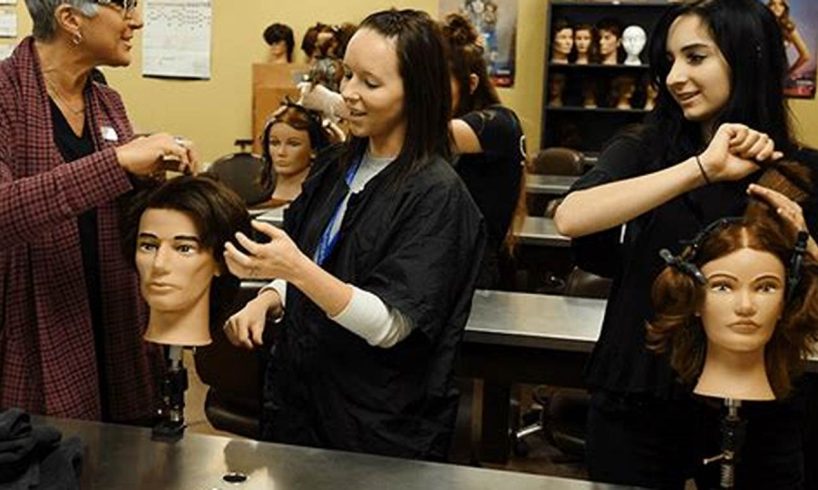
Cosmetology school for hair focuses on the study of hair care, including cutting, coloring, styling, and chemical treatments. The duration of cosmetology school for hair can vary depending on several factors, such as the level of certification or license desired, the specific program requirements, and the individual’s pace of learning.
The importance and benefits of cosmetology school for hair are multifaceted. It provides individuals with the knowledge, skills, and practical experience necessary to succeed in the hair care industry. Cosmetology school graduates are equipped to offer a wide range of hair services, from basic cuts and styles to advanced color techniques and hair treatments.
The duration of cosmetology school for hair typically ranges from 12 to 24 months, depending on the factors mentioned earlier. During this time, students undergo a combination of classroom learning and hands-on training, covering various aspects of hair care, including hair anatomy, hair chemistry, cutting and styling techniques, hair coloring, and salon management. Upon completion of the program, graduates are prepared to take the necessary licensing exams and enter the workforce as professional hair stylists.
1. Program Type
The type of cosmetology program one chooses directly influences the duration of their cosmetology school experience. These programs vary in the level of certification or license they provide, as well as the depth and breadth of their curriculum.
Certificate programs are typically the shortest, taking around 6 to 12 months to complete. They provide students with the foundational knowledge and skills necessary to work as a hairstylist or barber. Diploma programs are more comprehensive, typically taking 1 to 2 years to complete. They offer a broader range of courses, including advanced cutting and styling techniques, hair coloring, and salon management. Associate’s degree programs are the most extensive, taking 2 to 3 years to complete. They provide students with a well-rounded education in cosmetology, including not only practical skills but also business and management principles.
The choice of program type depends on the individual’s career goals and the specific requirements of the state or jurisdiction in which they plan to work. For those seeking a quick entry into the workforce, a certificate program may suffice. For those seeking a more comprehensive education and a broader range of career opportunities, a diploma or associate’s degree program may be a better choice.
2. Curriculum
The curriculum of a cosmetology school plays a pivotal role in determining the duration of the program. The specific courses and practical training included in the curriculum directly impact the amount of time required for students to complete the program and become qualified hairstylists.
A comprehensive curriculum that covers a wide range of topics, including hair cutting, coloring, styling, and chemical treatments, will typically require more time to complete than a more basic curriculum that focuses on fundamental hairdressing techniques. Additionally, programs that offer extensive hands-on training, such as supervised work in a salon environment, may take longer to complete than those that primarily focus on classroom instruction.
The importance of a well-rounded curriculum cannot be overstated. A strong curriculum provides students with the knowledge and skills they need to succeed in the competitive cosmetology industry. Graduates of programs with robust curricula are more likely to be well-prepared for the workforce and able to provide a wide range of services to their clients.
When choosing a cosmetology school, it is important to carefully consider the curriculum and ensure that it aligns with your career goals and the licensing requirements in your state or jurisdiction. A well-structured curriculum that provides a balance of theoretical knowledge and practical experience will ultimately help you become a successful and well-rounded hair stylist.
3. Hours Required
The total number of hours of instruction and hands-on experience required for cosmetology school is a crucial factor that directly influences the duration of the program. This requirement varies depending on the specific curriculum, program type, and licensing regulations in each jurisdiction. Understanding the connection between hours required and the length of cosmetology school is essential for aspiring hair stylists.
- Curriculum Coverage: The number of hours required is influenced by the depth and breadth of the curriculum. Programs with comprehensive curricula, covering a wide range of topics and techniques, typically require more hours to complete.
- Hands-on Training: Practical, hands-on training is a vital component of cosmetology education. Programs that emphasize hands-on experience, such as supervised work in a salon environment, may have higher hour requirements to ensure students develop the necessary skills and confidence.
- Licensing Regulations: State or provincial licensing boards often dictate minimum hour requirements for cosmetology programs. These regulations are in place to ensure that graduates meet the required level of competency before practicing.
- Program Type: The type of cosmetology program (certificate, diploma, or associate’s degree) also affects the number of hours required. Associate’s degree programs, which offer the most comprehensive education, typically have the highest hour requirements.
In summary, the number of hours required for cosmetology school is closely tied to the program’s curriculum, emphasis on hands-on training, licensing regulations, and program type. Understanding this connection is key for aspiring hair stylists as they navigate the various program options and determine the time commitment required to achieve their career goals.
4. Pace of Learning
The pace of learning is a crucial factor that influences the duration of cosmetology school. Students’ individual learning styles, prior knowledge, and personal circumstances can significantly impact the time it takes to complete the program.
- Learning Styles: Different learning styles affect the pace at which students absorb and retain information. Visual learners may excel in practical, hands-on training, while auditory learners may prefer lectures and discussions. Understanding one’s learning style can help students optimize their study methods and progress through the program more efficiently.
- Prior Knowledge: Students with prior experience in hair care or related fields may have a head start and progress faster through the program. They may already possess foundational knowledge and skills, allowing them to move through the curriculum more quickly.
- Personal Circumstances: External factors such as work schedules, family obligations, and personal commitments can influence a student’s pace of learning. Part-time students or those juggling multiple responsibilities may require more time to complete the program compared to full-time students.
- Program Structure: The structure of the cosmetology program can also impact the pace of learning. Programs with flexible schedules, self-paced learning options, or accelerated tracks may accommodate students with different learning needs and allow them to progress at their own pace.
Understanding the factors that influence the pace of learning can help students develop strategies to optimize their progress through cosmetology school. By maximizing their learning potential and seeking support when needed, students can efficiently complete the program and embark on their careers as skilled hair stylists.
5. Licensing Requirements
Licensing requirements play a significant role in determining the duration of cosmetology school for hair. These regulations establish minimum training hours that cosmetology schools must adhere to, ensuring that graduates possess the necessarypractical experience to provide hair services to the public.
- Standardization of Training: Licensing requirements ensure a standardized level of training across cosmetology schools. By setting minimum hour requirements, state or provincial authorities guarantee that all graduates have received a comprehensive education, regardless of the institution they attended.
- Public Safety: Licensing requirements prioritize public safety by ensuring that hair stylists are adequately trained to handle hair chemicals, styling tools, and other potential hazards. This helps protect clients from accidents, injuries, or improper hair care practices.
- Consumer Confidence: Licensing requirements instill confidence in consumers by assuring them that licensed hair stylists have met specific training standards. This can influence the duration of cosmetology school, as schools must allocate sufficient time to cover all the required topics and provide hands-on training to meet these standards.
- Career Opportunities: Licensing requirements can impact career opportunities for hair stylists. Holding a license demonstrates professionalism, credibility, and adherence to industry standards, which can enhance employment prospects and earning potential.
In summary, licensing requirements play a crucial role in determining the duration of cosmetology school for hair. By establishing minimum training hours, these regulations ensure the standardization of training, prioritize public safety, build consumer confidence, and expand career opportunities for hair stylists.
6. School Schedule
The school schedule, whether full-time or part-time, significantly impacts the duration of cosmetology school for hair. Students must carefully consider their time availability and personal circumstances when choosing a program.
- Full-time programs are typically designed to be completed in a shorter amount of time, ranging from 12 to 18 months. These programs require a significant time commitment, usually involving daily classes and hands-on training for several hours each day.
- Part-time programs offer a more flexible schedule, allowing students to balance their studies with other commitments such as work or family responsibilities. Part-time programs typically take longer to complete, often ranging from 24 to 36 months or more, as they involve fewer hours of instruction and hands-on training each week.
The choice between a full-time or part-time program depends on individual circumstances and goals. Full-time programs provide a faster track to completing cosmetology school, while part-time programs offer greater flexibility and accommodate various schedules. Both types of programs provide the necessary training and skills for a successful career in hair styling, and the duration of the program is ultimately influenced by the chosen schedule.
7. Prerequisites
Prerequisites, such as high school coursework or prior experience, play a role in determining the duration of cosmetology school for hair. These prerequisites ensure that students possess a foundation of knowledge and skills before embarking on the specialized training required for cosmetology.
High school coursework in subjects like science, math, and art can provide a strong foundation for cosmetology. Science courses offer an understanding of hair chemistry and the effects of various hair treatments. Math skills are essential for precise measurements and calculations in hair coloring and cutting. Art courses cultivate creativity and an eye for detail, crucial qualities for hair stylists.
Prior experience in hair care or related fields can also shorten the duration of cosmetology school. Individuals with experience in hairdressing, barbering, or beauty therapy may be able to skip or test out of certain courses, allowing them to progress through the program more quickly.
Understanding the connection between prerequisites and the duration of cosmetology school is important for prospective students. By fulfilling any required prerequisites before enrollment, students can optimize their time in school and accelerate their journey towards a successful career in hair styling.
FAQs
Individuals considering a career in cosmetology often have questions about the duration of their training. Here are some frequently asked questions and their answers to provide clarity on this aspect:
Question 1: How long does cosmetology school typically take to complete?
The duration of cosmetology school can vary depending on factors such as the program type, curriculum, and individual pace of learning. Generally, full-time programs may take around 12 to 18 months to complete, while part-time programs may take longer, ranging from 24 to 36 months or more.
Question 2: What factors influence the length of cosmetology school?
Several factors can influence the duration of cosmetology school, including the number of hours required for instruction and hands-on training, the curriculum’s comprehensiveness, licensing requirements, and the student’s pace of learning. Understanding these factors can help individuals make informed decisions about their educational journey.
Question 3: Are there any prerequisites for cosmetology school?
Some cosmetology schools may have prerequisites, such as high school coursework in science, math, or art. Prior experience in hair care or related fields may also be considered. Meeting these prerequisites can help students progress through the program more quickly.
Question 4: How can I choose the right cosmetology school for me?
Choosing the right cosmetology school involves considering factors such as program duration, curriculum, licensing requirements, and the school’s reputation. Researching different schools and visiting their facilities can help individuals make an informed decision that aligns with their career goals.
Question 5: What are the benefits of attending cosmetology school?
Attending cosmetology school provides individuals with the knowledge, skills, and practical experience necessary to succeed in the hair care industry. Graduates are equipped to offer a wide range of hair services and have the opportunity to build a fulfilling and rewarding career.
Question 6: What career opportunities are available to graduates of cosmetology school?
Graduates of cosmetology school have diverse career opportunities, including working as hair stylists, colorists, salon managers, platform artists, and educators. They can work in salons, spas, resorts, and other settings, offering their skills and expertise to clients.
Understanding the duration and factors influencing cosmetology school is crucial for individuals considering this career path. By carefully evaluating their options and choosing the right program, they can embark on a successful journey towards a rewarding career in the hair care industry.
Note: This article provides general information about the duration of cosmetology school for hair. Specific program lengths and requirements may vary depending on the institution and location. It is recommended to research and contact individual cosmetology schools for the most up-to-date and accurate information.
Tips for Choosing a Cosmetology School
Selecting the right cosmetology school is crucial for a successful career in the hair care industry. Here are several tips to consider when making your decision:
Tip 1: Research and Compare Programs:
Thoroughly research different cosmetology schools in your area. Compare their programs, curriculum, duration, and tuition fees to find the one that best aligns with your goals and budget.
Tip 2: Consider the School’s Accreditation and Reputation:
Choose a school that is accredited by a recognized body, ensuring the quality of its education and training. Check online reviews and testimonials from previous students to gauge the school’s reputation.
Tip 3: Visit the School and Attend Open Houses:
Visiting the school in person allows you to see the facilities, meet the instructors, and get a feel for the learning environment. Attend open houses or schedule a tour to gather more information.
Tip 4: Check Licensing Requirements:
Make sure the school’s program meets the licensing requirements in your state or jurisdiction. This ensures that you will be eligible to practice cosmetology upon graduation.
Tip 5: Consider the School’s Location and Schedule:
Choose a school that is conveniently located and offers a schedule that fits your lifestyle. Consider factors such as commute time, parking availability, and class hours.
Tip 6: Explore Financial Aid Options:
Research financial aid options, such as scholarships, grants, and loans, to help cover the cost of tuition and fees. Explore payment plans or installment options offered by the school.
Tip 7: Network with Industry Professionals:
Attend industry events, connect with hair stylists and salon owners, and seek their recommendations for cosmetology schools. Their insights can be valuable in making an informed decision.
Tip 8: Trust Your Instincts:
After considering all the factors, trust your instincts and choose the cosmetology school that feels like the right fit for you. Your personal preferences and learning style should be taken into account.
Following these tips can help you make a well-informed decision and choose a cosmetology school that will provide you with the knowledge, skills, and training necessary for a successful career in the hair care industry.
Transition to the article’s conclusion…
Conclusion
In summary, the duration of cosmetology school for hair varies depending on factors such as program type, curriculum, licensing requirements, and individual pace of learning. Understanding these factors allows aspiring hair stylists to make informed decisions about their educational journey.
Choosing the right cosmetology school is essential for a successful career in the hair care industry. By following the tips outlined in this article, individuals can select a program that aligns with their goals, preferences, and the specific requirements of their jurisdiction.
Embarking on cosmetology school is a significant step towards a fulfilling career in hair styling. Graduates are equipped with the knowledge, skills, and practical experience necessary to provide high-quality hair services and build a loyal clientele. The duration of cosmetology school may vary, but the rewards of a successful career in this dynamic and creative industry make it a worthwhile investment.






